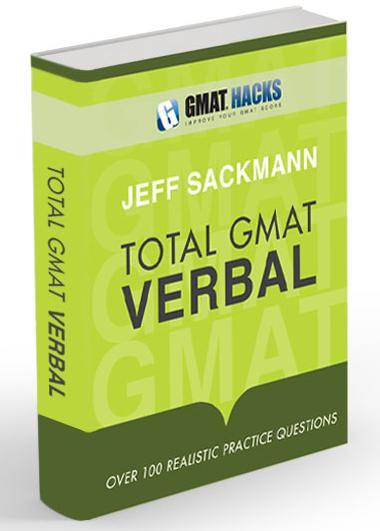
Bookshelf
|
|
Total GMAT Math Jeff's complete Quant guide, on sale now! |
|
|
Total GMAT Verbal Everything you need to ace GMAT Verbal! |
1,800 Practice Math Questions
Buy Jeff's books at Amazon.com

GMAT Official Guide, with IR
OG Math | OG Verbal
OG12 & Quant Rev solutions!
GMAT Question of the Day
Beginner's Guide to the GMAT
GMAT Hacks Affiliate Program

Recent Hacks

Categories
- General Study Tips
- Goals and Planning
- CAT Strategy
- The Mental Game
- GMAT Math Strategy
- GMAT Math Topics
- Mental Math
- Data Sufficiency
- Critical Reasoning
- Reading Comprehension
- Sentence Correction
- Analytical Writing Assessment
- Integrated Reasoning
- IR Explained
- Business School Admissions
- GMAT Prep Resources
- Practice Questions
- Total GMAT Math
- Total GMAT Verbal
- GMAT 111

Concrete Examples and GMAT Practice
| You should follow me on Twitter. While you're at it, take a moment to subscribe to GMAT Hacks via RSS or Email. |
A large number of GMAT math questions are word problems, and many of those refer to real-world situations. For instance, a combined rate question might be based on two hoses filling a pool, or a systems of equations problem might provide two relationships between the ages of two siblings.
Underlying all of these word problems are a smaller number of important mathematical concepts. In the two examples above, you need to know how to combine rates, and how to solve a system of equations, respectively.
The question, then, is how to learn those concepts in the first place. If you were brought up in the United States, you may have had teachers who prioritized teaching concepts through real-world examples. (This approach is not nearly so prevalent elsewhere, though it does exist.) There's some research that supports learning through realistic examples, and educators seem to like it even more than the research would support.
Concepts First
Now, a group of researchers have concluded the opposite: It's better to learn the concepts. Here's a link to a press release about the study, and an excerpt:
The issue can also be seen in the story problems that math students are often given, she explained. For example, there is the classic problem of two trains that leave different cities heading toward each other at different speeds. Students are asked to figure out when the two trains will meet."The danger with teaching using this example is that many students only learn how to solve the problem with the trains," Kaminski said.
"If students are later given a problem using the same mathematical principles, but about rising water levels instead of trains, that knowledge just doesn't seem to transfer," she said.
You can probably see how this applies to studying for the GMAT.
Questions vs. Skills
I encourage my students to spend much of their time doing practice questions--after all, the GMAT is relatively predictable, and there are thousands of quality practice questions out there. But I say that with a major caveat.
When you study a GMAT practice question, your goal isn't to walk away from the question with the ability to do that question. If you're working out of one of my resources, or from The Official Guide, I can guarantee you that that specific question won't be on the test.
The underlying concept, though, very well might be on the test.
Let's put this study technique in the terms of the study I've mentioned. In an ideal world, you'd start by learning concepts. My Total GMAT Math aims to do just that. However, you can't learn every GMAT-related math concept before looking at a question. You will, fairly often, see practice questions that you can't answer.
When that happens, don't focus on the precise details of that question. Instead, determine what the underlying concepts are. Do you need to know the relationship between a semicircle and an inscribed triangle? How to find the ratio of weights in a weighted average problem?
Every single GMAT practice question you will ever do draws upon a handful of basic techniques, skills, and concepts. Prioritize those, and you'll have much more success than the students who limit themselves to the questions on the page.
About the author: Jeff Sackmann has written many GMAT preparation books, including the popular Total GMAT Math, Total GMAT Verbal, and GMAT 111. He has also created explanations for problems in The Official Guide, as well as 1,800 practice GMAT math questions.
 |
Total GMAT Verbal
The comprehensive guide to the GMAT Verbal section. Recognize, dissect, and master every question type
you'll face on the test. Everything you need, all in one place, including 100+ realistic practice questions. |